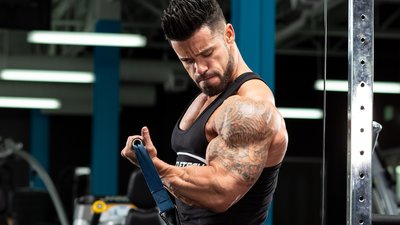When you first started out in fitness, all you had to do for arms was enter the weight room, curl a dumbbell, flex in the mirror a few times, and leave with a superb pump. But to build mass above the elbow and the strength to go with it, you need solid strategies with a proven track record of success.
These four tips all but guarantee growth. Follow them accordingly when you curl the weight, and your body will qualify for the "sleeves optional" club in no time.
Tip 1: Prepare Your Biceps Individually
Warm up your arms and forearms one side at a time. By using this strategy, each side of the body does its own work and won't rely on the other side for help. This establishes a stronger mind-muscle connection for each gun, and you'll be more productive as you curl throughout your workout.

The dumbbell concentration curl is a perfect exercise for this employing technique. Most people use this arm curl as a finisher, but the lift may serve you even better as a starter. As the name implies, you're "concentrating" on each arm on its own, contracting and stretching the muscles while preparing the elbow and the forearm for what's to come in your workout. Using this focused, single-arm technique to curl the dumbbell is an all-around win for better biceps growth and greater strength.
Performance tip: Your elbow should not move during this curl.
Tip 2: Isolate Your Biceps and Hit Them Heavy
Singles and doubles on the biceps curl won't do much when it comes to hypertrophy, but you should still load up those pythons with a serious amount of weight before you arm curl. The key is to use an exercise that isolates the upper arms so they can't depend on other muscles, such as the shoulder, for help and prevents "cheating" through momentum during the curl.
The most obvious choice for a heavy isolation exercise is, of course, the preacher curl. The preacher curl braces the upper arm so the biceps have to do the work while virtually eliminating all momentum. You can go with a barbell for this lift if you want, but the EZ-curl bar is easier on the wrists, which means less chance of an injury during a curl. The dumbbell also works for this exercise.

Tip 3: Don't Forget the Brachialis When You Curl
Working the brachialis it isn't just about perfecting that peak. This little muscle that lies underneath is vital to performance and the overall look of the arm. The brachialis is an important part of your upper-arm mass.
The hammer curl with dumbbells, performed with a neutral grip, is known far and wide for its brachialis-building ability. Using the cross-body version will help you get an even better contraction at the top of the curl. Resist the urge to let the ease of the hammer curl distract you. You still need to focus on tension and contraction throughout the entire rep of each biceps curl. As tempting as it is to run the rack and build an insane pump, focused and controlled reps will be worth it when the tape measure stretches on your biceps muscle.

Tip 4: Flood with Blood
At the end of the day, the biceps curl is all about the pump, right? That feeling of tightness is what makes the training worth it. The end of your workout is where you can focus on getting that massive pump and finishing your session strong.
The cable curl is awesome for pumping blood above the elbow. The load of the cable machine maintains tension throughout the range of motion, and you can adjust your angles to hit different areas of the muscle. Squeeze tight, curl hard, and lower slowly.
Here's a bonus tip for the cable curl: Do these 21s style. Perform 7 bottom-half reps, 7 top-half reps, and 7 full reps. You might have to lower the weight by the time you get to the last set, but your strength will increase over time if you stick with this method as you curl.



